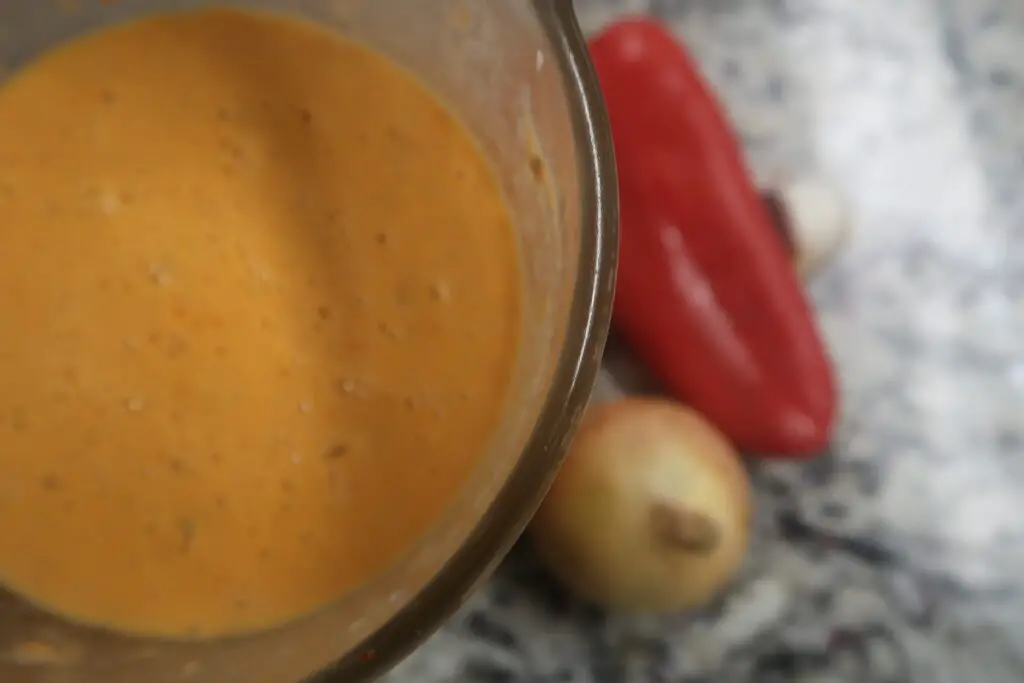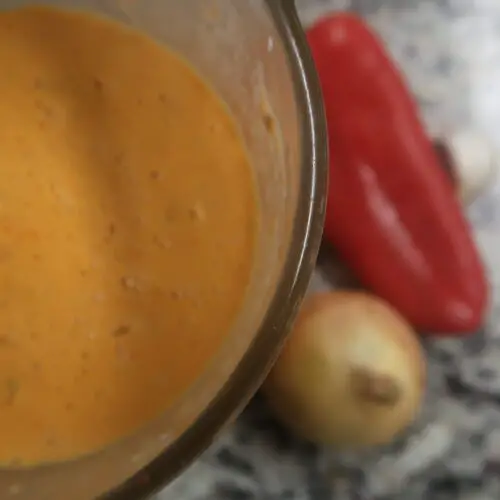Delicious Roasted Vegetable Sauce
By Toya. L
This post may contain affiliate links. Please read our disclosure policy
Elevate your meal creations with our delicious Roasted Vegetable Sauce. Crafted from a symphony of meticulously roasted vegetables, this sauce is a culinary masterpiece that adds a burst of rich, smoky flavor to your dishes. Our Roasted Vegetable Sauce is a harmonious blend of heavy cream, sweet bell peppers, earthy tomatoes, Jalapenos, and aromatic garlic and onions, all artfully roasted to perfection. This slow-roasting process infuses the ingredients with a depth of flavor that transforms every bite into a culinary adventure.

❤️Why you will love this Roasted Vegetable Sauce❤️
- Flavor Concentration: Roasting vegetables involves cooking them at high temperatures, which caramelizes their natural sugars and intensifies their flavors. This process creates a rich, savory, and slightly sweet taste that is highly appealing.
- Maillard Reaction: The Maillard reaction occurs during roasting, leading to the development of complex flavors and aromas. This reaction involves the browning of amino acids and reducing sugars in the vegetables, resulting in a deep, roasted flavor profile.
- Nutrient Retention: Roasting vegetables retains more of their natural flavors and nutrients compared to other cooking methods, such as boiling or steaming. This preservation of nutrients and flavors contributes to the sauce’s overall tastiness.
- Versatility: Roasted vegetable sauce goes well in many different recipes, and it can be made using a variety of vegetables, allowing for a combination of different flavors and textures. This versatility allows you to tailor the sauce to your preferences and dietary needs.
- Natural Sweetness: Roasting brings out the natural sweetness in vegetables, making the sauce taste naturally sweet without the need for added sugars or sweeteners.
INGREDIENTS:
- 4 Tomatoes
- 1 Red Pepper
- 2 Jalapeno Peppers
- 3 Garlic Cloves
- 1/2 Yellow Onion
- 1 cup Heavy Cream
- 1/4 tsp Salt
Roasted Vegetable Sauce Instructions:
Prepare a baking pan: Place a sheet of parchment paper on a baking pan.
Prepare vegetables: Cut 4 tomatoes in half, cut 1 red pepper in half, cut 1/2 of an onion, 3 garlic cloves, and cut the 2 jalapenos in half, and place the vegetables face down on the prepared baking sheet. Top the vegetables off with salt and broil at 500°F for 25-30 minutes.
Blend the vegetables: Remove the roasted vegetables from the oven and allow them to cool. To a blender add the heavy cream, and the roasted vegetables. Blend until everything is blended well.

Roasted Vegetable Sauce
Equipment
- 1 Blender
Ingredients
- 4 Tomatoes
- 1 Red pepper
- 2 Jalapeno peppers
- 1/2 Onion
- 3 Garlic cloves
- 1 cup Heavy cream
Instructions
- Prepare a baking pan: Place a sheet of parchment paper on a baking pan.
- Prepare vegetables: Cut 4 tomatoes in half, cut 1 red pepper in half, cut 1/2 of an onion, 3 garlic cloves, and cut the 2 jalapenos in half, and place the vegetables face down on the prepared baking sheet.
- Top the vegetables off with salt and broil at 500°F for 25-30 minutes.
- Blend the vegetables: Remove the roasted vegetables from the oven and allow them to cool. To a blender add the heavy cream, and the roasted vegetables. Blend until everything is blended well.
Video
Nutrition
Tips for making Roasted Vegetable Sauce:
- Roasting Time: Roast the vegetables until they are tender and slightly caramelized. This can take anywhere from 20 to 45 minutes, depending on the vegetables and their size. Keep an eye on them to prevent burning.
- Browning: Don’t be afraid to let the vegetables develop some browned, crispy edges. This adds depth and complexity to the sauce.
- Cooling: Allow the roasted vegetables to cool slightly before blending. This prevents the steam from building up in the blender, which can cause splattering and be dangerous.
- Blending: Use a high-quality blender or food processor to puree the roasted vegetables until smooth. You can add a bit of vegetable stock, broth, or water to reach your desired consistency.
- Adjust Seasoning: Taste the sauce and adjust the seasoning as needed. You might need to add more salt, pepper, or herbs to achieve the perfect balance of flavors.
FLAVOR VARIATIONS:
- Spicy Roasted Vegetable Sauce:
- Add roasted red chili peppers or a pinch of red pepper flakes for heat.
- Include smoky spices like paprika or chipotle powder for a smoky kick.
- Herbaceous Roasted Vegetable Sauce:
- Incorporate fresh herbs like basil, parsley, cilantro, or dill into the sauce for a vibrant, herbaceous flavor.
- You can also add some fresh lemon zest or juice to brighten up the sauce.
- Creamy Roasted Vegetable Sauce:
- Blend in a dollop of Greek yogurt, sour cream, or to create a different creamy version of the sauce.
- For a dairy-free option, use coconut milk or a plant-based creamer.
- Mediterranean Roasted Vegetable Sauce:
- Enhance the sauce with Mediterranean flavors by adding ingredients like kalamata olives, capers, and a drizzle of extra-virgin olive oil.
- Consider using roasted red peppers for an authentic Mediterranean twist.
- Roasted Garlic and Onion Sauce:
- Roast extra garlic cloves and onions alongside your other vegetables for a deeply savory and aromatic sauce.
- Sauté the roasted garlic and onions in olive oil before blending for a sweeter, caramelized flavor.
- Umami-Boosted Roasted Vegetable Sauce:
- Add ingredients like sun-dried tomatoes, dried porcini mushrooms (rehydrated), or a dash of soy sauce to intensify the umami notes in the sauce.
- Roasted Vegetable Pesto:
- Combine roasted vegetables with traditional pesto ingredients like fresh basil, pine nuts, Parmesan cheese, and garlic for a pesto-style sauce.
- Curry-Infused Roasted Vegetable Sauce:
- Incorporate curry powder or a blend of curry spices for an Indian-inspired roasted vegetable sauce.
- Add coconut milk or yogurt for creaminess and balance.
- Roasted Red Pepper and Tomato Sauce:
- Roast red bell peppers and tomatoes together for a sweet and tangy sauce.
- Include roasted garlic and basil for added depth of flavor.
- Savory Roasted Vegetable Sauce:
- Boost the savory aspect with ingredients like roasted shallots, mushrooms, or a dash of Worcestershire sauce.
- Use vegetable or mushroom broth as a base for added depth.
- Smokey Roasted Vegetable Sauce:
- Introduce a smoky flavor with ingredients like smoked paprika, smoked sea salt, or a touch of liquid smoke (use sparingly).
Storage Instructions:
- Refrigeration: If you plan to use the roasted vegetable sauce within a week, store it in an airtight container in the refrigerator. Follow these steps:
- Allow the sauce to cool to room temperature after blending.
- Transfer it to a clean, airtight container, leaving a small amount of space at the top to allow for expansion.
- Seal the container tightly and label it with the date for reference.
- Store in the refrigerator for up to 7 days.
- Short-Term Freezing: If you intend to use the sauce within a few weeks, you can freeze it in small portions. Here’s how:
- Portion the sauce into freezer-safe containers or resealable freezer bags.
- Remove as much air as possible to minimize freezer burn.
- Seal the containers or bags tightly, label them with the date and quantity, and place them in the freezer.
- Use within 2-3 months for the best quality.
Freezing Instructions:
If you want to store the roasted vegetable sauce for an extended period, consider these freezing instructions:
- Cooling: Allow the sauce to cool to room temperature after blending.
- Portioning: Divide the sauce into individual serving sizes or the portion you typically use in recipes. This makes it easier to thaw only what you need without having to defrost the entire batch.
- Freezer Bags: Alternatively, you can use ice cube trays to freeze small portions of the sauce. Once frozen, transfer the sauce cubes to a freezer bag for easy access.
- Container Selection: Use airtight freezer-safe containers or vacuum-sealed bags designed for freezer storage. Make sure the containers are leak-proof and seal well.
- Labeling: Clearly label the containers or bags with the date of preparation and any other relevant information, such as the sauce type or quantity.
- Removing Air: If using bags, remove as much air as possible to prevent freezer burn. With containers, fill them almost to the top to minimize air space.
- Stacking: If you’re stacking containers or bags, consider placing a piece of parchment paper between them to prevent sticking.
- Storage Location: Place the labeled containers or bags in the coldest part of your freezer, typically toward the back or on a freezer shelf, not in the door where temperature fluctuations can occur.
Thawing and Using Frozen Roasted Vegetable Sauce:
When you’re ready to use the frozen sauce, follow these steps:
- Refrigerator Thawing: For the best results, transfer the container of frozen sauce to the refrigerator and allow it to thaw slowly overnight or for several hours. This gradual thawing helps preserve the sauce’s quality.
- Quick Thawing: If you need to use the sauce more quickly, you can place the sealed container or bag in a bowl of cold water. Change the water every 30 minutes until the sauce has thawed. Do not use hot water, as it can partially cook the sauce.
- Heating: Once thawed, gently reheat the sauce on the stovetop over low to medium heat or in the microwave, stirring occasionally until it’s heated through.
- Use Within a Timely Manner: Once the sauce is thawed and heated, use it promptly and do not refreeze it.
Properly stored and frozen, Roasted Vegetable Sauce can maintain its quality and flavor for several months, allowing you to enjoy its deliciousness in various dishes whenever you like.
FREQUENTLY ASKED QUESTIONS:
- What vegetables are commonly used in roasted vegetable sauce?
- Common vegetables used in roasted vegetable sauce include bell peppers, tomatoes, onions, garlic, zucchini, carrots, eggplant, and mushrooms. You can choose a combination that suits your taste.
- What dishes can I use roasted vegetable sauce in?
- Roasted vegetable sauce is versatile and can be used as a pasta sauce, pizza sauce, sandwich spread, or as a topping for grilled meats, fish, or vegetables. Its uses are limited only by your creativity. We use this delicious sauce in our Cheesy Cream of Spinach Chicken, and our Enchiladas.
- Can I make roasted vegetable sauce in advance?
- Yes, you can make roasted vegetable sauce in advance and store it for later use. It’s a convenient way to have a flavorful sauce on hand for quick and delicious meals.
- Are there any dietary considerations for roasted vegetable sauce? – Roasted vegetable sauce can be adapted to various dietary preferences. For example, you can make it vegan by avoiding dairy products or gluten-free by selecting vegetables and seasonings without gluten-containing ingredients. It is both low in carbs, and keto friendly.